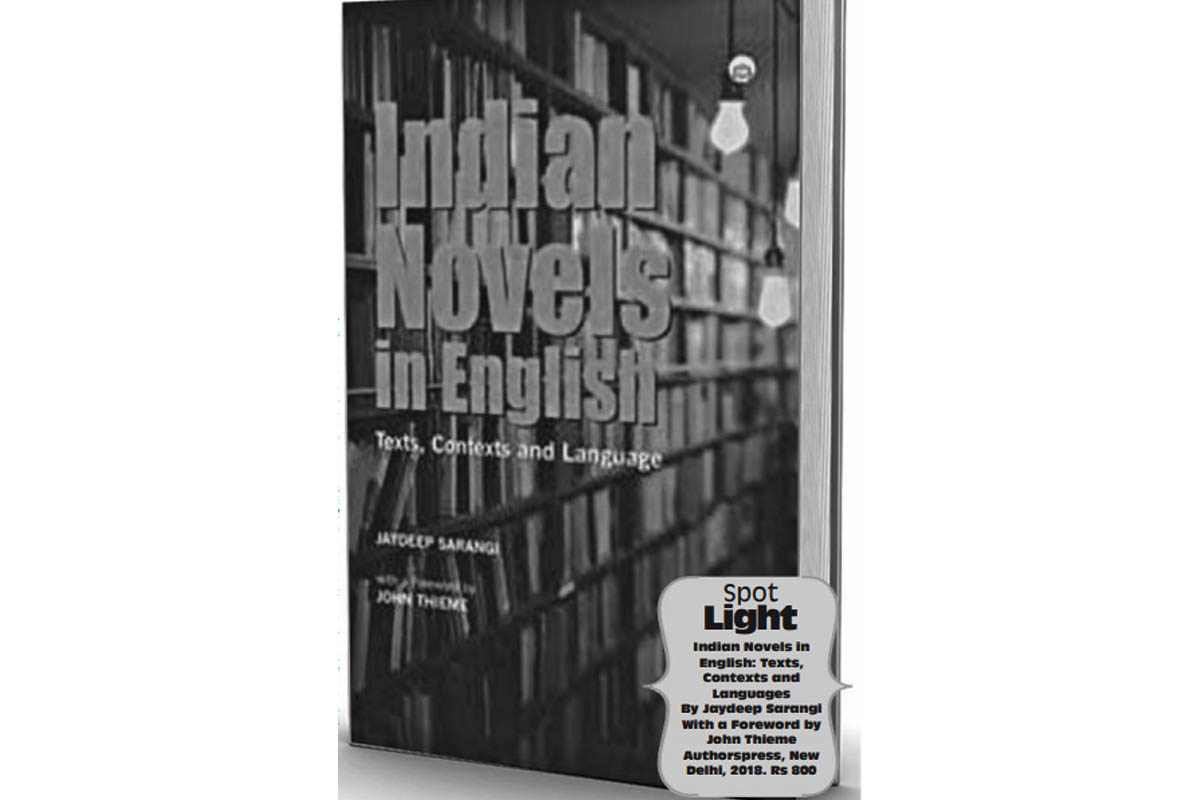Animals and humans
Why not see the world through a new lens and realise that all of us are the same? It will make it easier for you not to make them suffer, or tolerate people and decisions that make them suffer.
The book takes us through canonical Indian English novels that span over 70 years thereby charting the trajectory that language, culture, cultural nuances, regional negotiations have influenced the texts under consideration and is a good addition to critical work in the area … A review.

Photo: SNS
Jaydeep Sarangi is a poet who, as Shyamala A Narayan in the blurb to the book under review says, “brings the sensitivity of a poet to his analysis of the language of Indian English fiction.” In his Foreword to the book, John Thieme writes that language is both “an individual and social phenomenon”. Basabi Fraser notes in her blurb that the study reveals the way the “bilingualism of Indian writers enriches their fictional narratives.”
Language and construction of identity is the basis of Sarangi’s study of some of the “registers through which Indian novelists writing in English in the last 70 years of the 20th century gave voice to their concerns”. The novels under scrutiny span from the last years of the Independence struggle to the turn of the Millennium. Thieme further notes that this sociolinguistic study of the some of the most representative Indian English novels “demonstrates the nativisation of English”.
Published in an earlier version as Indian Novels in English: A Sociolinguistic Study, 2005, this study develops on the earlier book. The book under review analyses the language used by the characters in the novels under consideration in terms of theories of nativisation of the English language to suit the Indian ethos and characters. In the introduction, Sarangi clearly reveals the subject of his study. Speaking of language, sociology, linguistics and sociolinguistics, he highlights his rationale for his choice of novels and the methodology of the study.
Advertisement
He speaks in detail of sociolinguistics and the various theories that he uses to analyse the Indian English novels. Stylistics and discourse analysis are also referred to. Using sociolinguistic theories and principles, the study traces what constitutes an Indian sensibility by examining the language used in the novels. Speech Act Theory, Politeness principle and Cooperative principle are applied to Indian novels in English to study the way sociolinguistic theories function in the novels under consideration. It is interesting to note the way all the authors under consideration use literal translation to create setting and character.
The novels under consideration span a large period from the 1930s to the last decade of the twentieth century and can be divided into four periods ~ pre-Independence, the years just after independence (the 1950s and 1960s), the 1970s and 1980s and the 1990s. Mulk Raj Anand’s Untouchable (1935) and Coolie (1936), Raja Rao’s Kanthapura (1938) and The Serpent and the Rope(1960), RK Narayan’s The Guide (1958), Bhabani Bhattacharyya’s So Many Hungers!(1947), He Who Rides a Tiger(1954) and A Dream in Hawaii (1978), Khushwant Singh’s Train to Pakistan(1956), Rama Mehta’s Inside the Haveli (1977), Anita Desai’s Clear Light of Day (1977) and Fasting, Feasting (1980), Amitav Ghosh’s The Shadow Lines(1988) and The Calcutta Chromosome (1995) and Arundhati Roy’s The God of Small Things(1997).
Sarangi’s study highlights the use of the English language and its nuances in a socio-cultural context in these novels, which are now canonical texts in Indian Writing in English. In his analysis, Sarangi reveals the way each of these novelists has found their own voice, their own way of using the English language. Interspersed in many of the novels are words, idioms and usages from the novelists’ regional languages and other linguistic influences. The early novels of RK Narayan, for instance reveal the influence of Graham Greene. Raja Rao, Mulk Raj Anand and Narayan worked their way in using English to work at creating a characteristic style.
The Serpent and the Rope, though set in France, for instance, is very much Indian in idiom and philosophy with European expletives used to create a hybridity that characterises the Indian novel in English. As Sarangi notes, there is an adaptation of English to Indian needs and the assertion of an Indian identity that is presented in the incidents and situations in the novel.
Excepting The Guide, which is analysed briefly, the rest of the novels under consideration in the study are analysed in great detail. Passages from the novels are explained pointing out to the finer nuances of language. Sarangi also explains the morphology of words used in the novels.
In Amitav Ghosh’s The Shadow Lines, Sarangi points to the code mixing, which speaks of the dialogue between Bengal and England which is central to the novel’s ideas of place and identity ~ “Code-mixing is a sociolinguistic reality”. He refers to this code mixing in Coolie too and says that “It reflects the Indianness of the sociolinguistic trends in India.”(p.55) The God of Small Things marks a movement away from standard English in the late 20th century Indian novels in English. Sarangi shows that in Roy’s novel, nativisation is no longer about the differences in Indian speech and thought patterns.
The book takes us through canonical Indian English novels that span over 70 years thereby charting the trajectory that language, culture, cultural nuances, regional negotiations have influenced the texts under consideration and is a good addition to critical work in the area. It would have been nice if this well mounted book would have been a little less priced.
The reviewer is Associate Professor, Department of English, Brahmananda Keshab Chandra College, Kolkata.
Advertisement